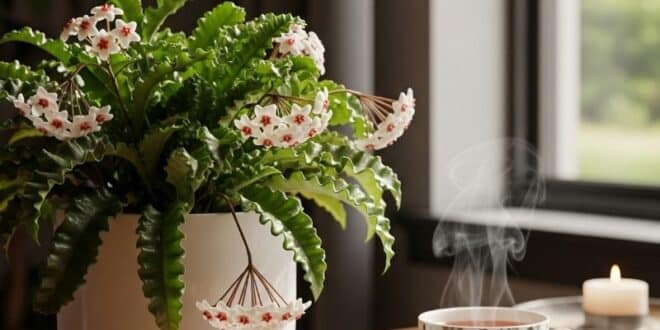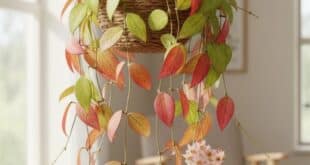Meet Hoya Lacunosa
If you’ve ever walked into a room and been greeted by a sweet, spicy fragrance you just couldn’t place, you might have been in the presence of a Hoya lacunosa. Of all the gems in the vast Hoya universe, this one is a true standout, and for so many wonderful reasons.
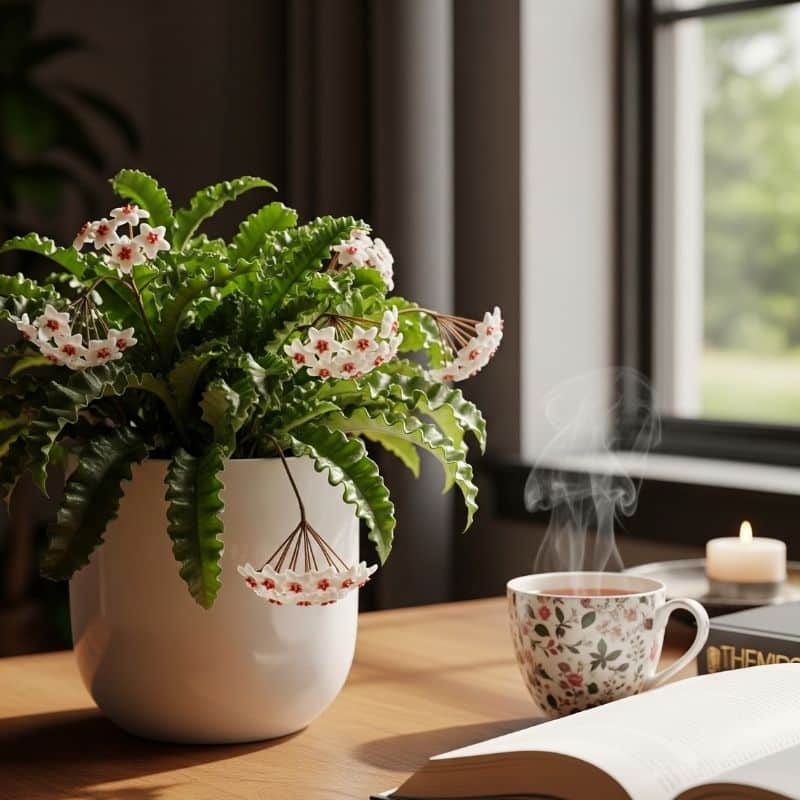
While many Hoyas are grown for their beautiful, waxy foliage, the Hoya lacunosa plant offers a complete sensory experience. It’s known for its uniquely textured leaves, its willingness to bloom, and—the real showstopper—its incredible perfume.
But it’s not just a pretty face. It’s a relatively easy-going plant that’s perfect for both beginners and seasoned Hoya collectors looking for something special. So, let’s dive into everything that makes this ‘crinkle leaf’ Hoya a must-have and how you can help it thrive in your home.
What Makes the Hoya Lacunosa So Special?
Before we get into the nuts and bolts of care, let’s appreciate what sets this Hoya apart from its more common cousins, like the classic Hoya carnosa.

- The ‘Crinkle’ Leaves: The name lacunosa means ‘pitted’ or ‘full of gaps,’ which perfectly describes its leaves. Unlike the smooth, glossy leaves of many other Hoyas, these have a wonderful, dimpled, or wrinkled texture. They are typically smaller and thinner, giving the plant a more delicate and graceful appearance.
- That Intoxicating Fragrance: This is arguably its biggest claim to fame. When it blooms, the Hoya lacunosa produces clusters of small, fuzzy, cream-colored flowers. During the day, they’re lovely to look at. But at night, they release a powerful, sweet, and sometimes cinnamon-like fragrance that can fill an entire room. It’s a delightful surprise.
- A Generous Bloomer: Are you tired of waiting years for your Hoya to flower? Good news! The Hoya lacunosa is known for being one of the most reliable and frequent bloomers in the family. It often flowers at a younger age and can produce blooms on and off throughout the growing season with the right care.
Hoya Lacunosa vs. Hoya Carnosa: A Quick Comparison
To put it in perspective, here’s a quick comparison with the classic Wax Plant most people know.
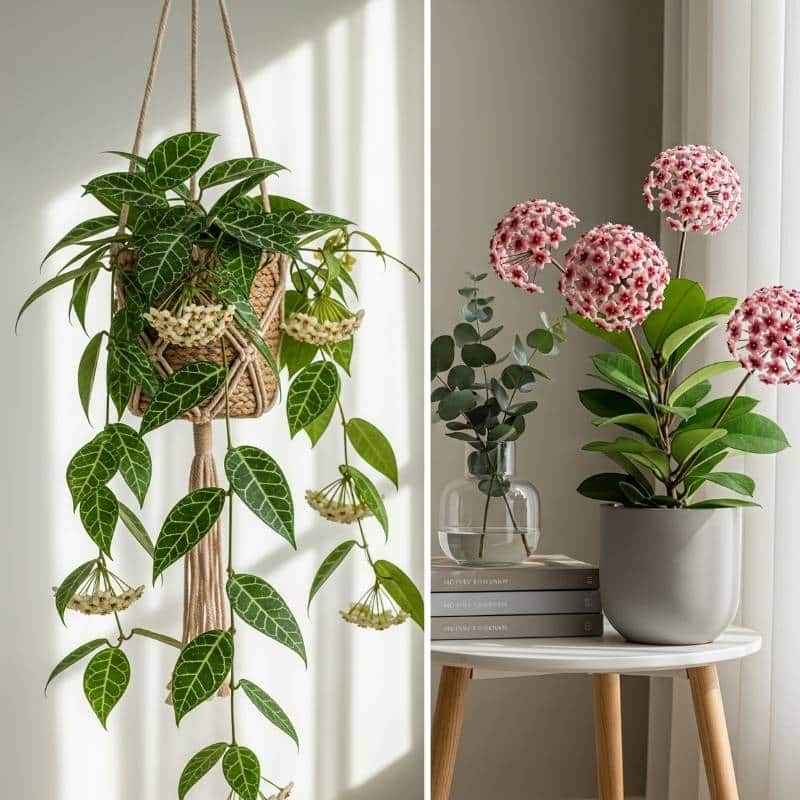
| Feature | Hoya Lacunosa (‘Crinkle Leaf’ Hoya) | Hoya Carnosa (‘Classic Wax Plant’) |
| Leaves | Thinner, smaller, with a unique dimpled/crinkled texture. | Thick, fleshy, and smooth with a waxy surface. |
| Flower Scent | Strong, sweet & spicy, perfume-like (often compared to cinnamon). | A gentle, sweet aroma often characterized by hints of chocolate or vanilla. |
| Flower Appearance | Tiny, soft, cream-colored flowers shaped like stars. | Big, glossy, star-shaped flowers in pink or white, featuring a red center. |
| Blooming Habit | A vigorous and frequent bloomer, often starting at an early stage. | May bloom less readily, typically needing greater maturity to do so. |
| Growth Habit | A more delicate, trailing vine perfect for hanging baskets. | A robust, woody vine that loves to climb or trail. |
Hoya Lacunosa Care: Helping Your Plant Thrive
Truth be told, caring for a Hoya lacunosa is not difficult. It just has a few preferences. Get these right, and it will reward you generously.
Light:
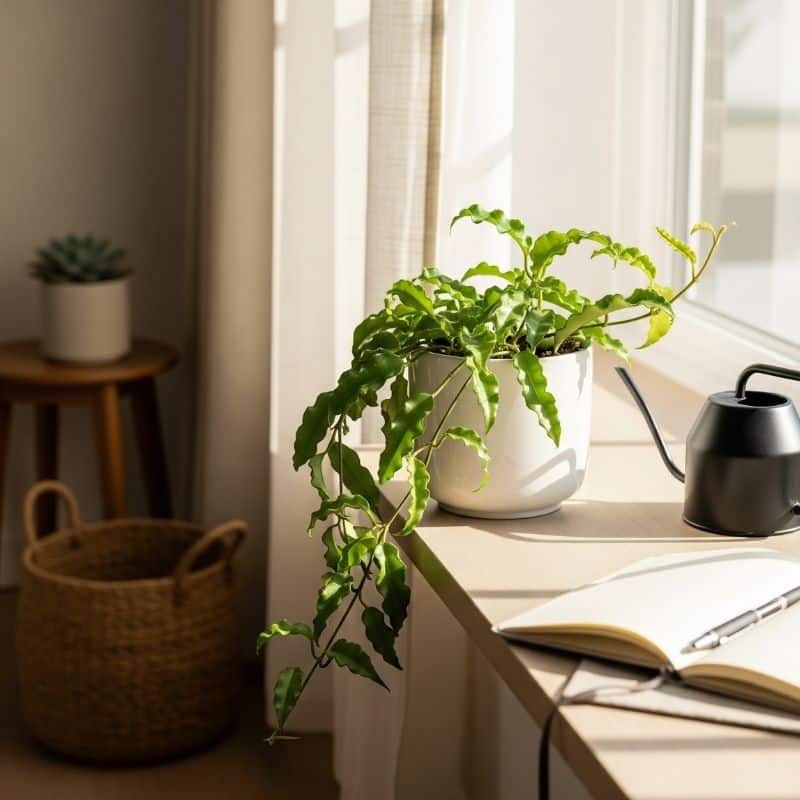
Bright but Gentle Like most Hoyas, the Hoya lacunosa thrives in bright, indirect light. Consider placing it near an east-facing window to enjoy soft morning sunlight, or a few feet away from a south or west-facing window. The Lacunosa Difference: Its thinner leaves can be more susceptible to scorching than the thick leaves of a Hoya carnosa. If you see yellowing leaves or brown, crispy spots, it might be getting too much direct, harsh sun.
Watering:
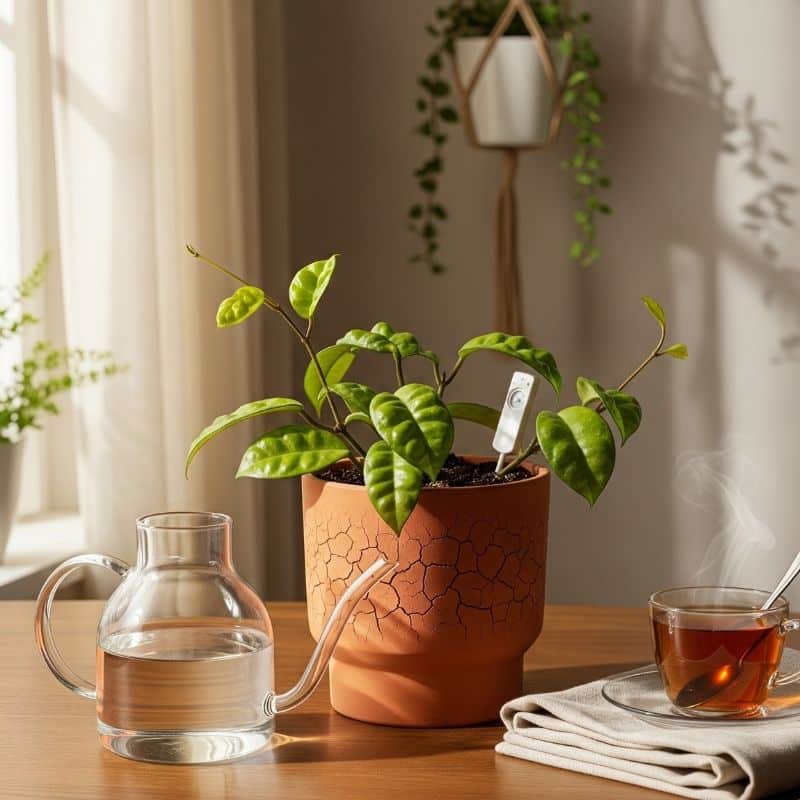
The ‘Dry Out’ Rule This is the most critical part of Hoya care. Hoyas hate having “wet feet.” Water your plant thoroughly, letting the excess drain away completely. Let the top 1-2 inches of soil dry out entirely before watering it again. How to tell when it’s thirsty? The leaves will lose a bit of their firmness and may look slightly puckered. Slightly underwatering is preferable to overwatering. In winter, you’ll need to water even less often.
Soil:
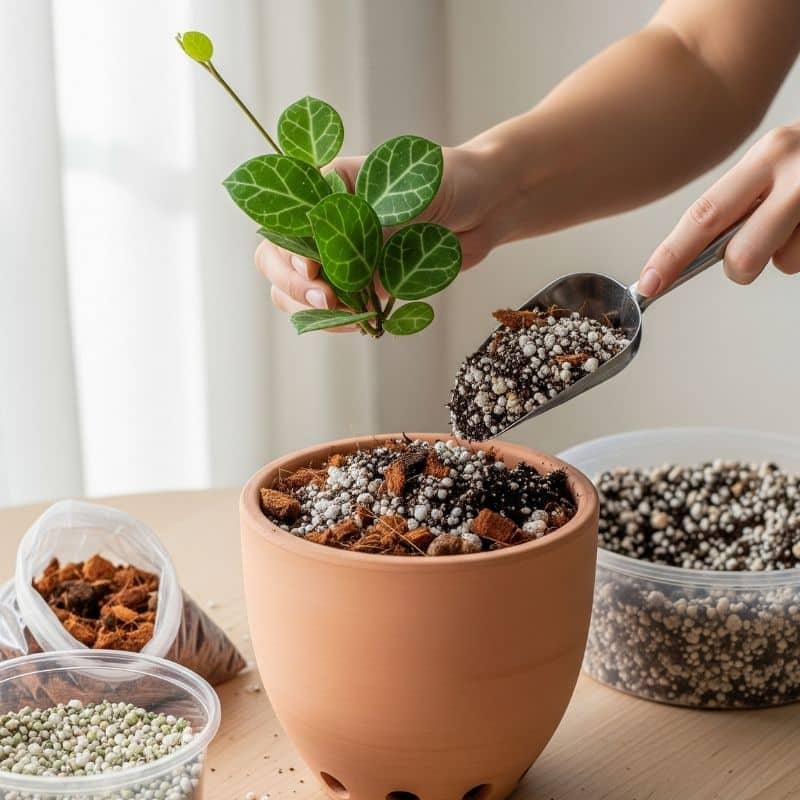
It’s All About Airflow Remember, in nature, many Hoyas are epiphytes—they grow on trees, not in dense soil. Their roots need to breathe. A standard potting mix is too heavy. You need a chunky, airy, and well-draining mix. You can buy a pre-made aroid or orchid mix, or create your own using orchid bark, perlite, coco coir, and a small amount of potting soil.
Humidity and Temperature:
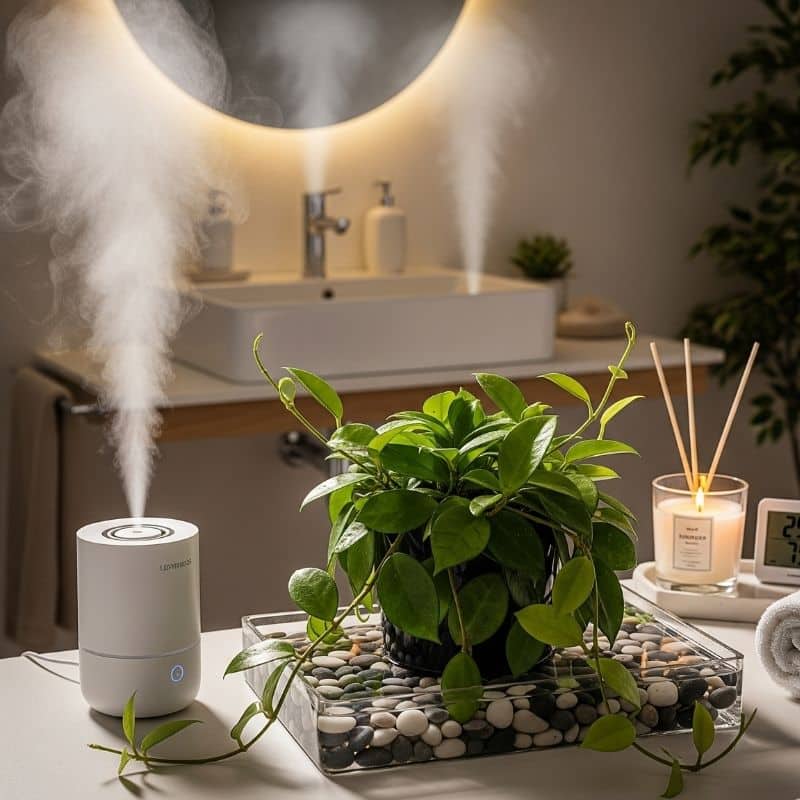
A Tropical Dream Your Hoya lacunosa will be happiest in average room temperatures (18-27°C / 65-80°F) and appreciates higher humidity (ideally 50-60% or more). While it can tolerate average household humidity, boosting it will lead to healthier growth and more blooms. Placing it in a bathroom, near a humidifier, or on a pebble tray are all great options.
Fertilizing:
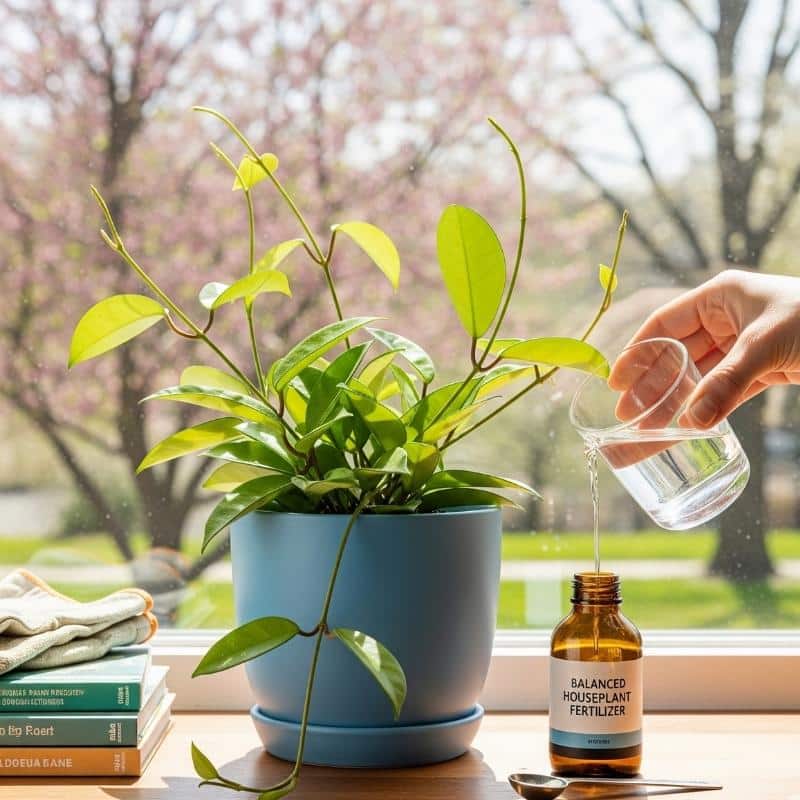
Light Feeds for a Frequent Bloomer During the growing season (spring and summer), you can feed your Hoya lacunosa with a balanced houseplant fertilizer diluted to half-strength every 3-4 weeks. Because it’s a frequent bloomer, it appreciates the consistent, light source of nutrients. Do not fertilize in the fall and winter.
Troubleshooting Common Issues
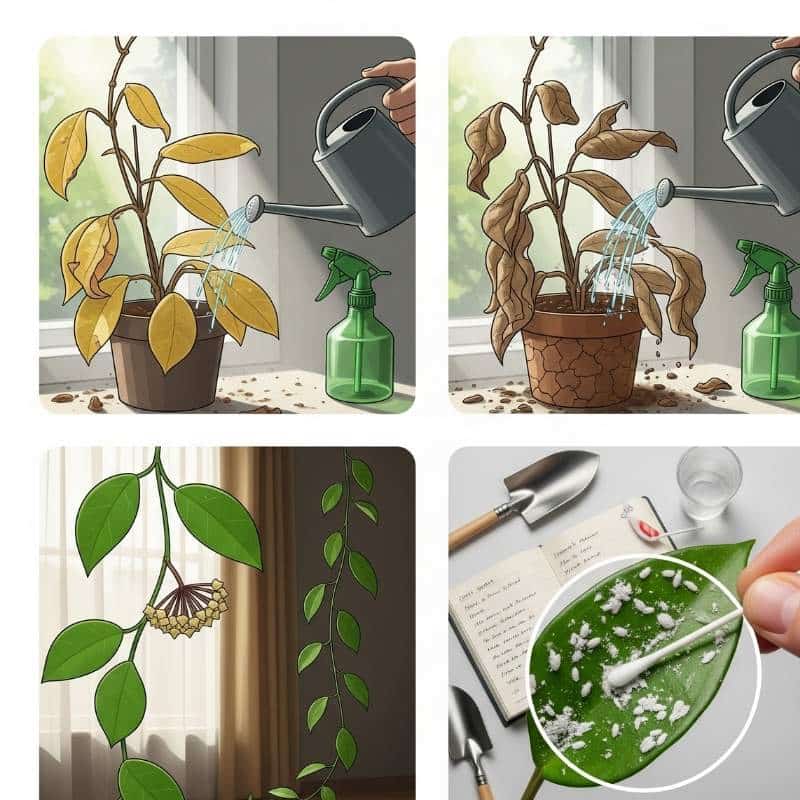
Even the happiest plants can run into trouble. Here’s a quick guide to what your Hoya lacunosa might be trying to tell you.
| Observed Problem | Possible Cause(s) | How to Fix It |
| Yellowing Leaves | Most often overwatering. Can also be too much direct sun. | Check the soil. Let it dry out completely. Water less frequently. If sun is the issue, move it to a spot with less direct light. |
| Wrinkled, Limp Leaves | Underwatering or root rot (from previous overwatering). | First, check the soil. If bone dry, water it thoroughly. If the soil feels wet but the leaves remain limp, inspect the roots for black, mushy indications of rot. |
| Not Blooming | Not enough light; the plant is too young; you cut off the old flower spurs (peduncles). | Move to a brighter location. Be patient! And never cut off the little woody spurs where flowers once grew—new flowers will form there again! |
| Leggy Growth | Not enough light. | The plant is stretching to find more light. Move it to a brighter spot. |
| Pests | Mealybugs (small white fuzzy spots) are a common pest for Hoyas. | Inspect your plant regularly. If pests are present, remove them using a cotton swab dipped in rubbing alcohol or apply insecticidal soap to the plant. |
Frequently Asked Questions (FAQ) about Hoya Lacunosa
Here are some quick answers to the most common questions about the charming Hoya lacunosa.
1. Is Hoya lacunosa toxic to cats and dogs?
Great news for pet owners! According to the ASPCA, Hoya lacunosa, like most plants in the Hoya genus, is considered non-toxic to cats and dogs. However, it’s always a good practice to prevent pets from chewing on any houseplant, as it can cause mild stomach upset.
2. How long do Hoya lacunosa flowers last?
While the plant blooms frequently, the individual flower clusters (umbels) themselves typically last for about 5 to 7 days. The delightful fragrance is usually strongest for the first few days, especially in the evening and at night.
3. Is Hoya lacunosa a fast grower?
Yes, compared to many other Hoya species like the slow-growing Hoya carnosa, the Hoya lacunosa is generally considered a moderately fast grower. Under ideal conditions (good light, humidity, and warmth), you can expect to see significant new vine growth during the spring and summer.
4. How big does a Hoya lacunosa get?
Hoya lacunosa is a relatively compact and manageable plant, which makes it perfect for smaller spaces. Its trailing vines can reach lengths of 3-5 feet (about 1-1.5 meters) or more over time, but it’s not an aggressively large plant. You can easily keep it smaller by occasionally pruning the vines.
5. Why are my Hoya lacunosa leaves turning yellow?
The number one cause of yellow leaves on a Hoya lacunosa is overwatering. Its fine roots are very sensitive to sitting in waterlogged soil, which leads to root rot and yellowing leaves. Always ensure the top inch or two of soil is completely dry to the touch before watering.
Ready to Enjoy the Fragrance?
The Hoya lacunosa plant is a true gem. It packs so much character into a small, manageable package—from its touchable leaves to its unforgettable scent. It proves that you don’t need a massive, difficult plant to make a huge impact.
By giving it the bright, indirect light it craves and being careful not to overwater, you’ll have a happy, healthy, and stunningly fragrant companion for years to come.

